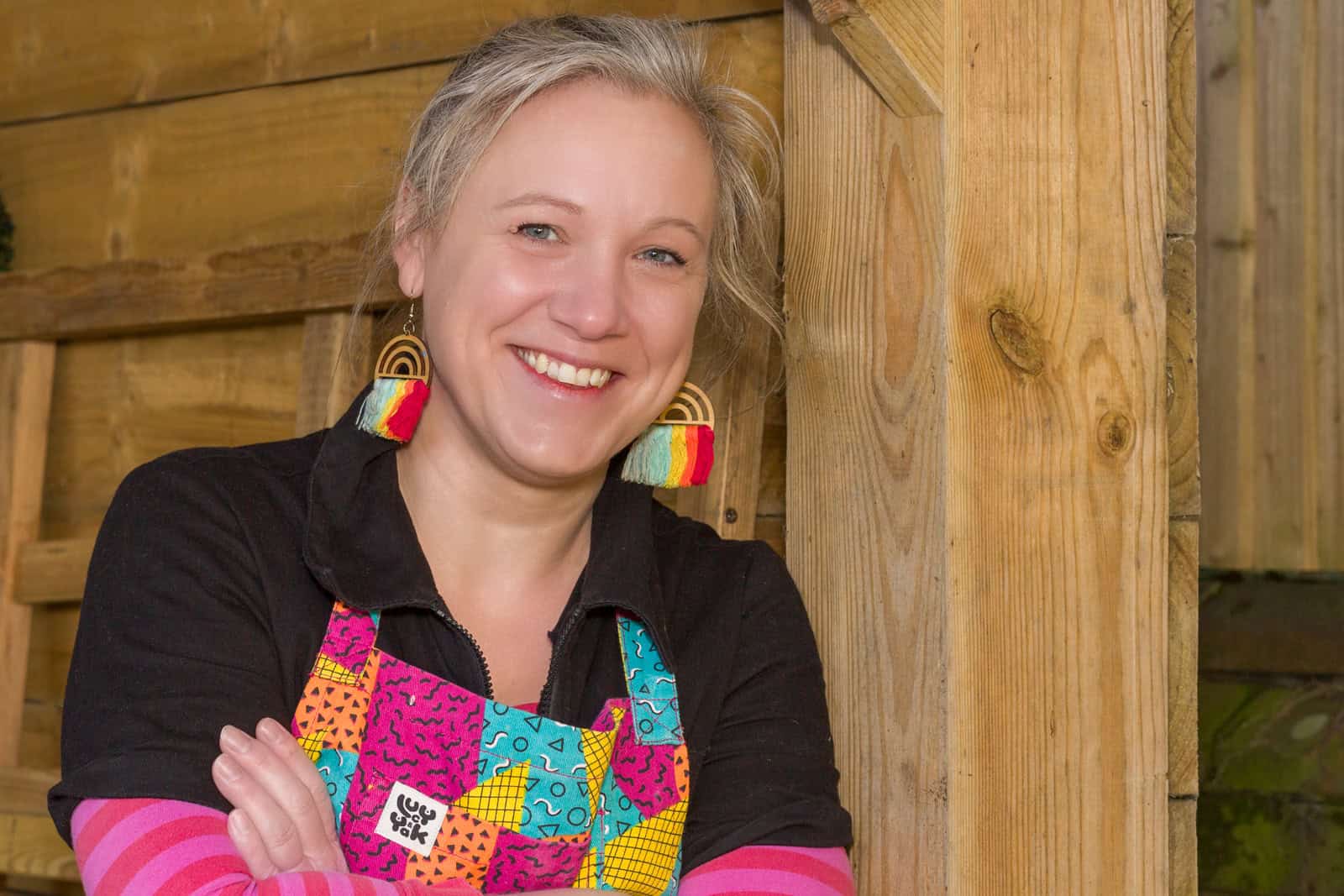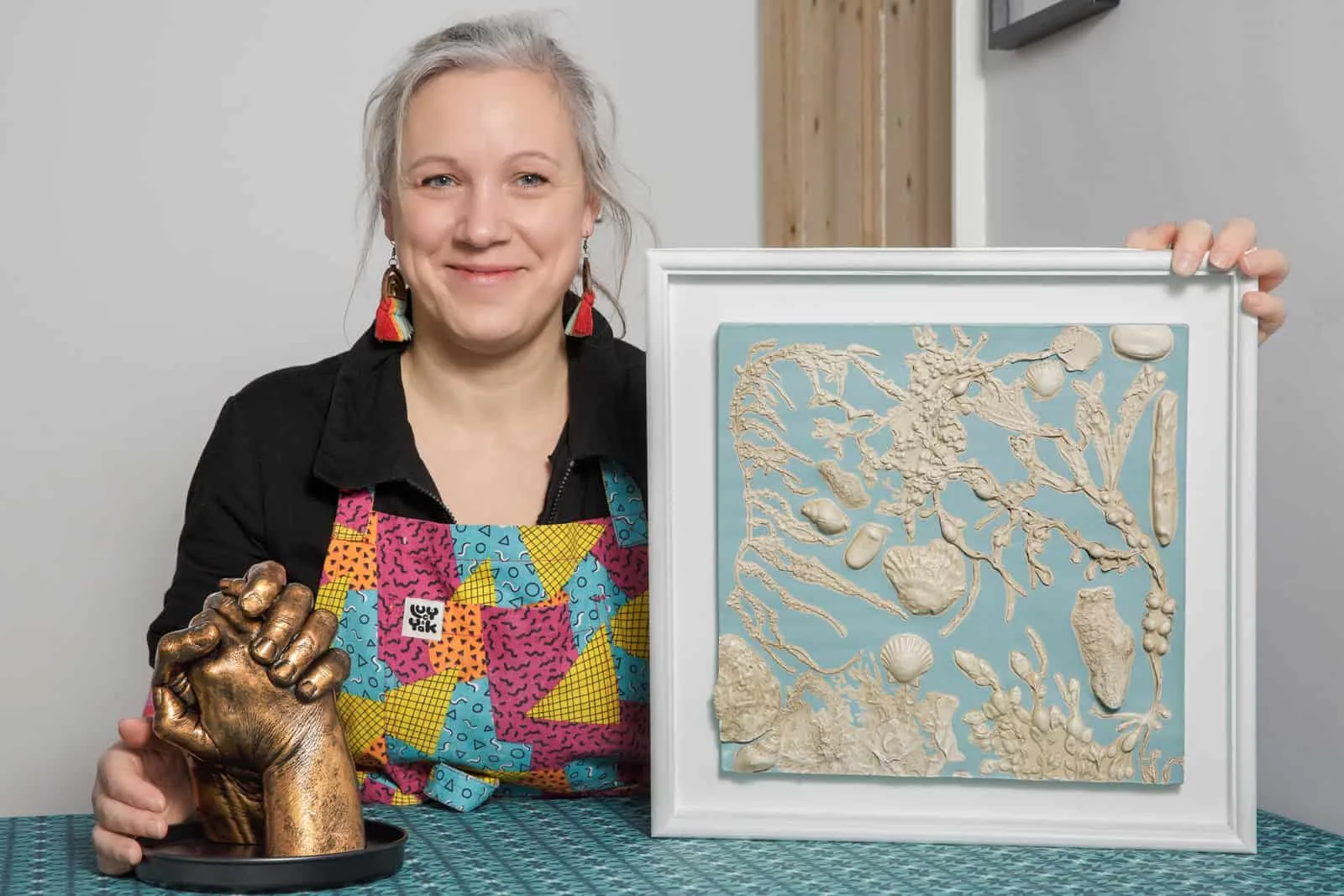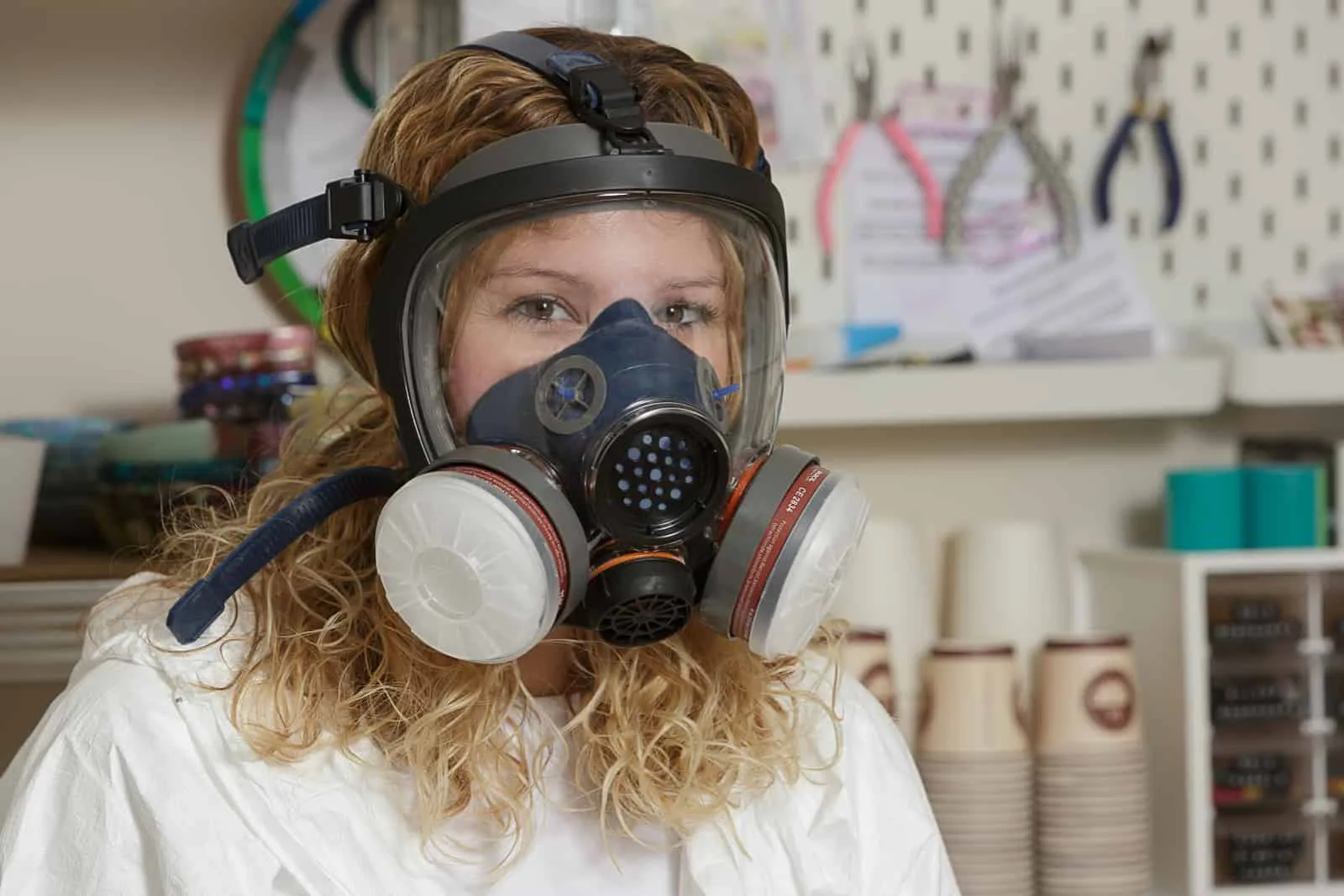Introduction
Finding inspiration in nature, Jo creates botanical and coastal castings by pressing natural elements into clay to form moulds for unique plaster pieces. Her work reflects the changing seasons, and she finds the entire process deeply therapeutic.
This is part two of a three-part story.
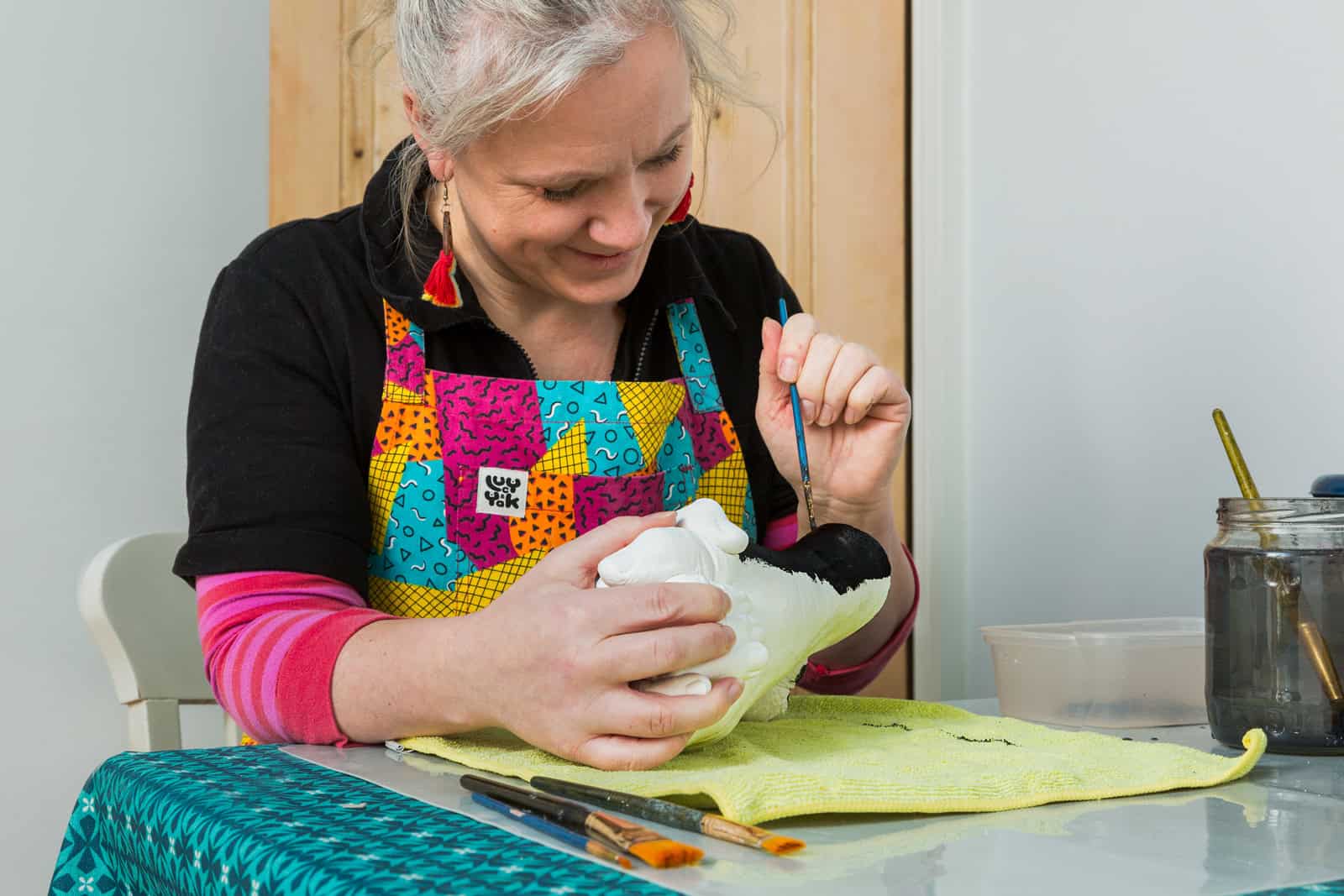
Do you have a dedicated area for working in?
Unfortunately I don’t have a studio, so I’m currently using my dining room table as a work area. However, we have a sheltered gazebo in the garden which I use if the weather is good. I really enjoy being outside if I can.
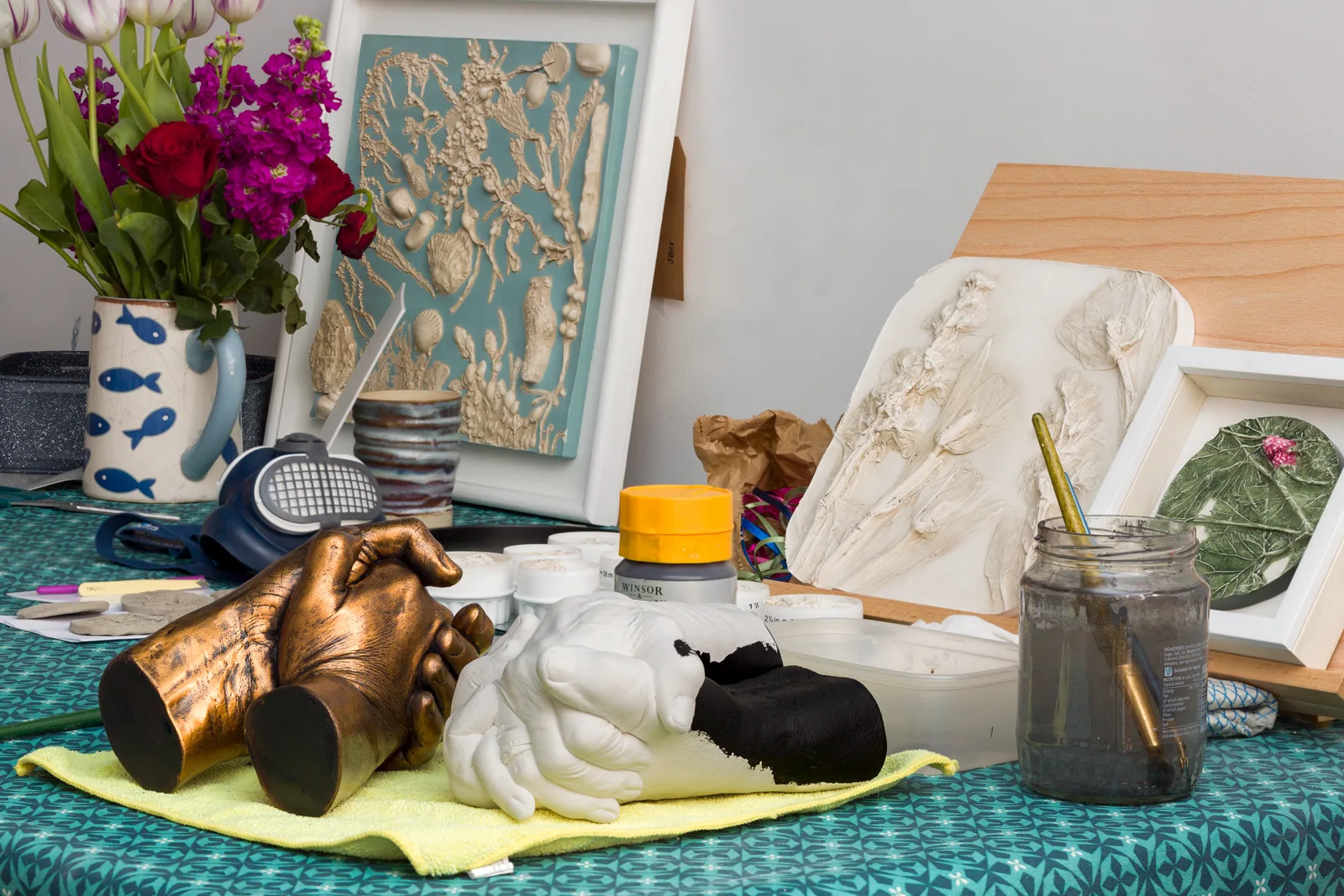
In touch with nature [laughs]
Yes [Laughs]. One of my dreams is to have a little studio somewhere. Maybe having a garden room where the gazebo is, or we could build into the loft space. Some of the houses in our area have cellars, and they are often turned into music or games rooms. Ours is an overflow storage area at the moment, and a bit damp, so it’s not suitable as it is. But who knows, one day maybe.
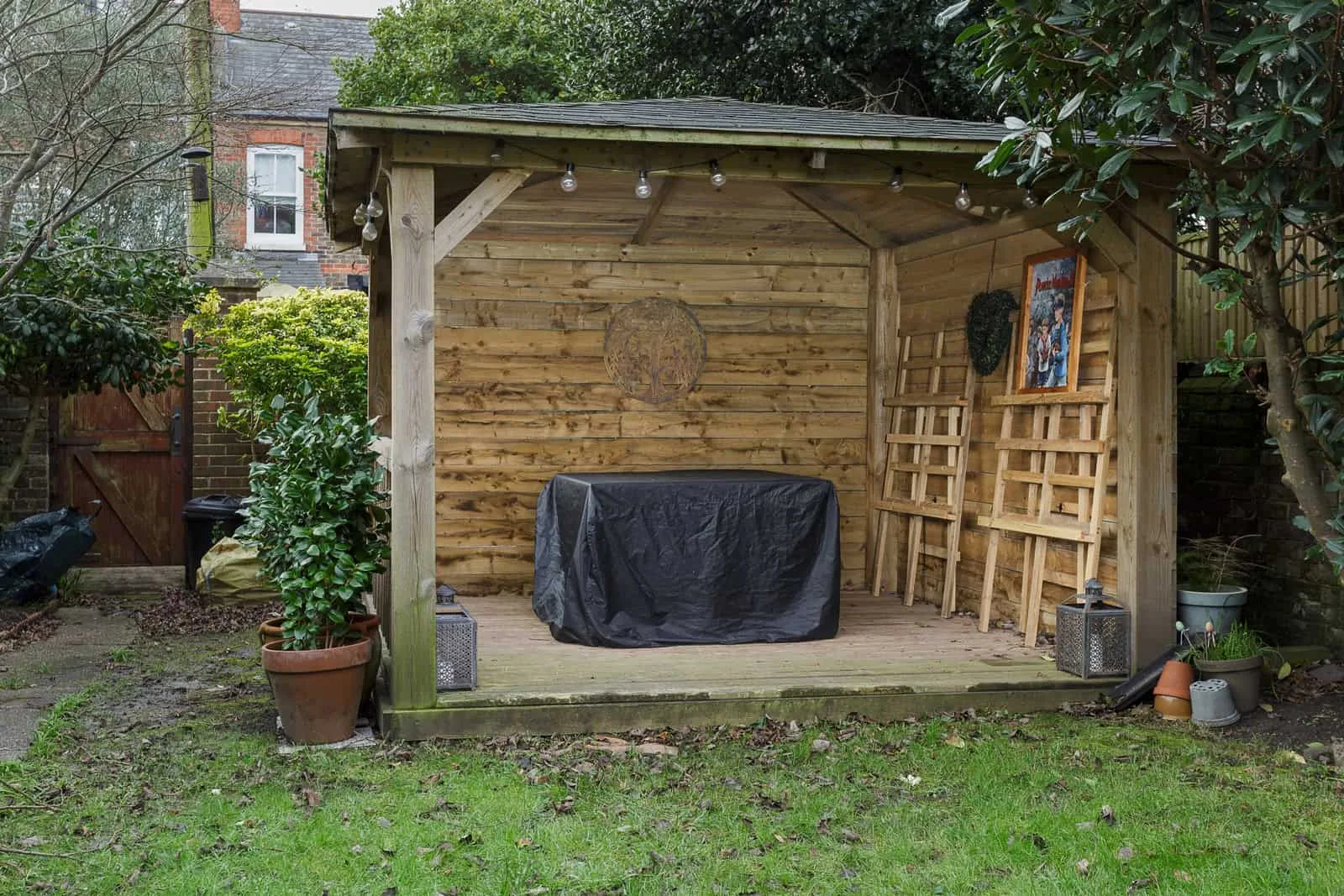
Garden Gazebo – alternative work area
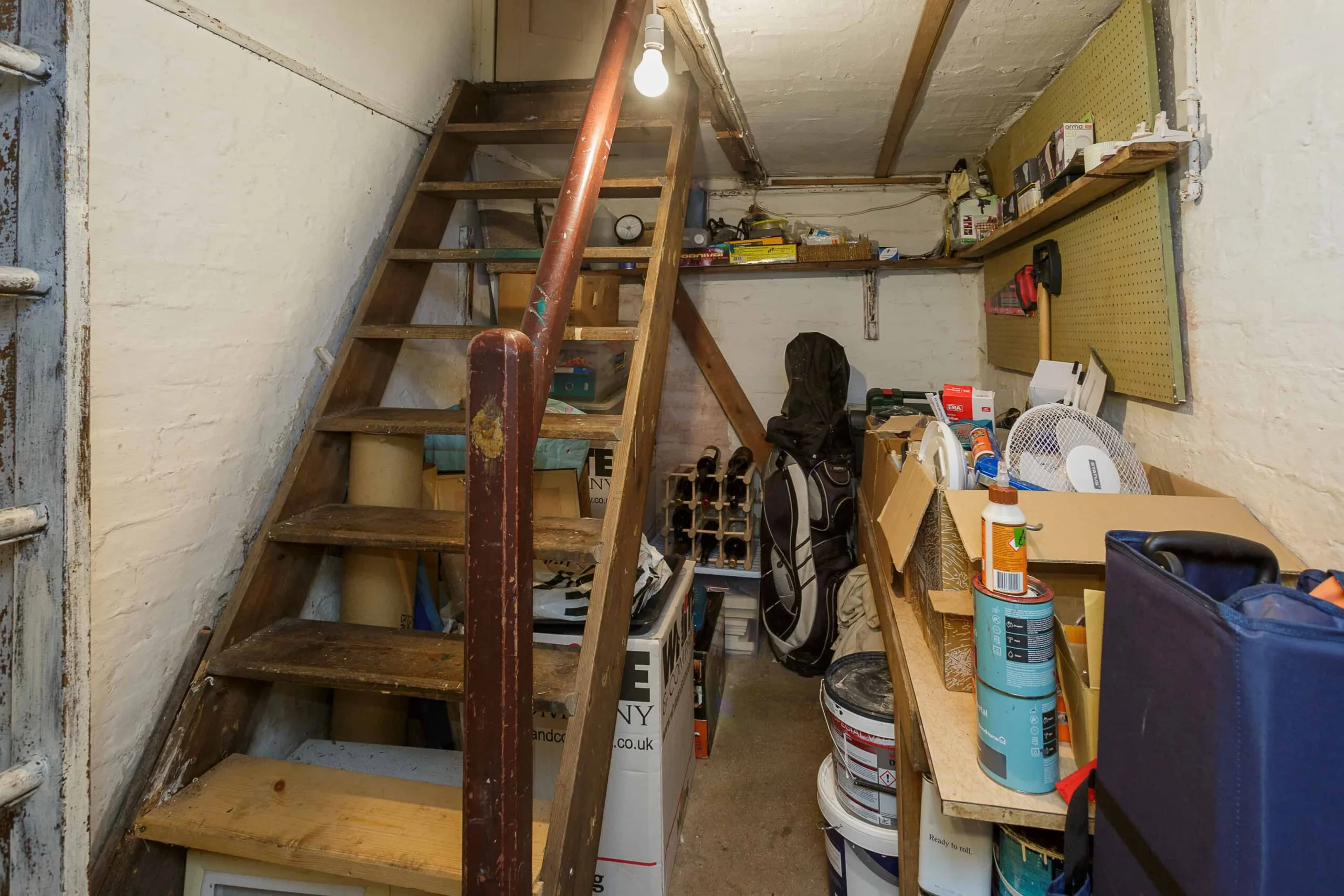
Cellar / Basement – alternative storage area
What’s the workflow, or process for creating a casting?
Well, first of all the clay is rolled out flat and even, just like making pastry. Then the materials, foliage, shells, flower heads etc. are pressed into the clay in the composition of your choice. The way I approach it is to think of the design as if it were a wreath or bouquet. The relief is in reverse, so the trick is to visualise the mirror-image effect that it will have. The materials then have to be removed with tweezers without disturbing anything.
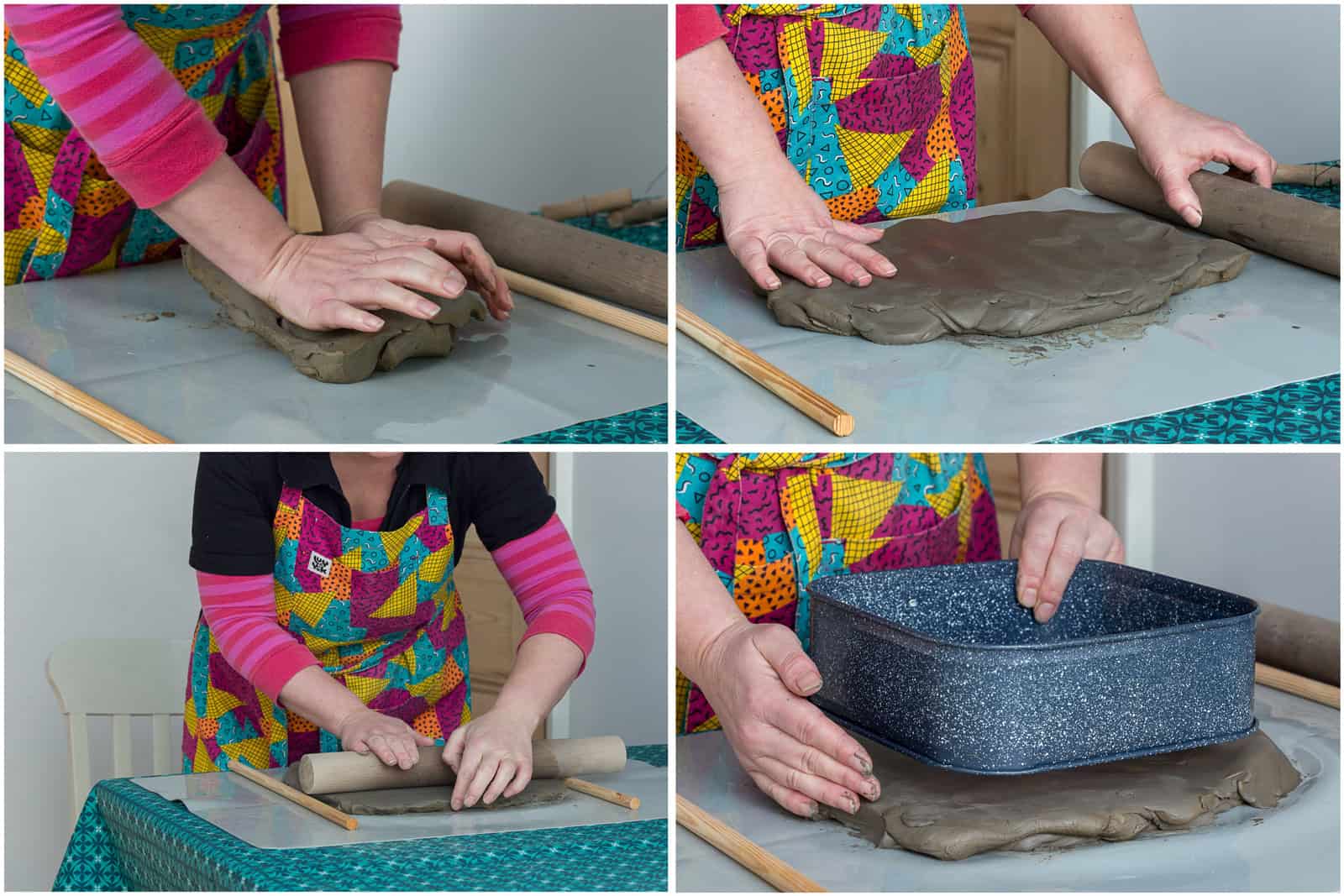
Preparing the clay
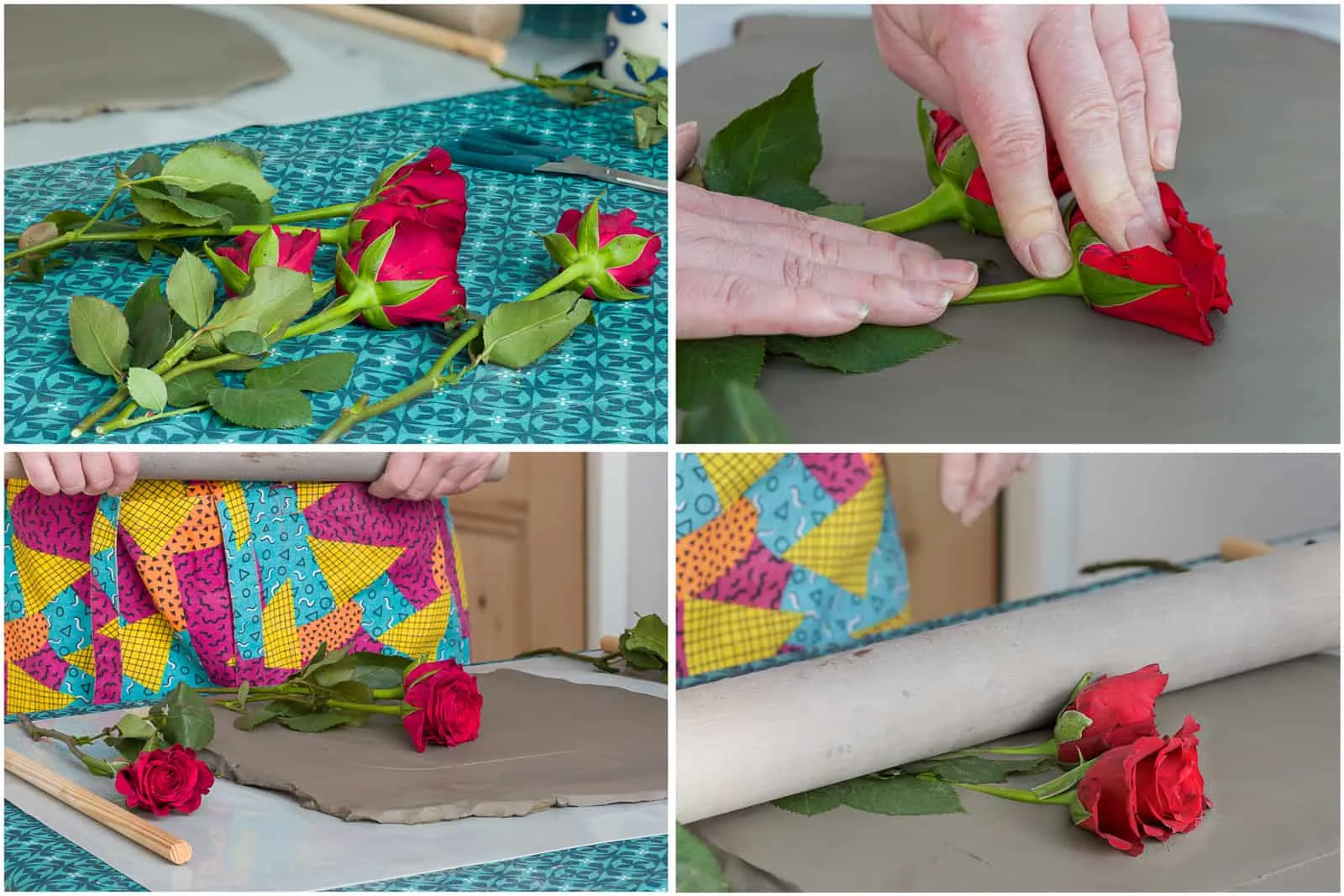
Creating a mould from pressed roses

Removing flower petals from the mould
This is the mould that you’re creating at this stage?
Yes, once it’s all clean, the next stage is to pour the plaster of paris into the newly created mould. For the larger pieces I’ve had wooden frames made that are painted prior to use. They’re also oiled to help with removing the cast from the frame. Once the plaster’s set, usually after a couple of hours, the relief cast is released from the clay but kept in the frame until it’s fully hardened and dry; normally in about 3 days.
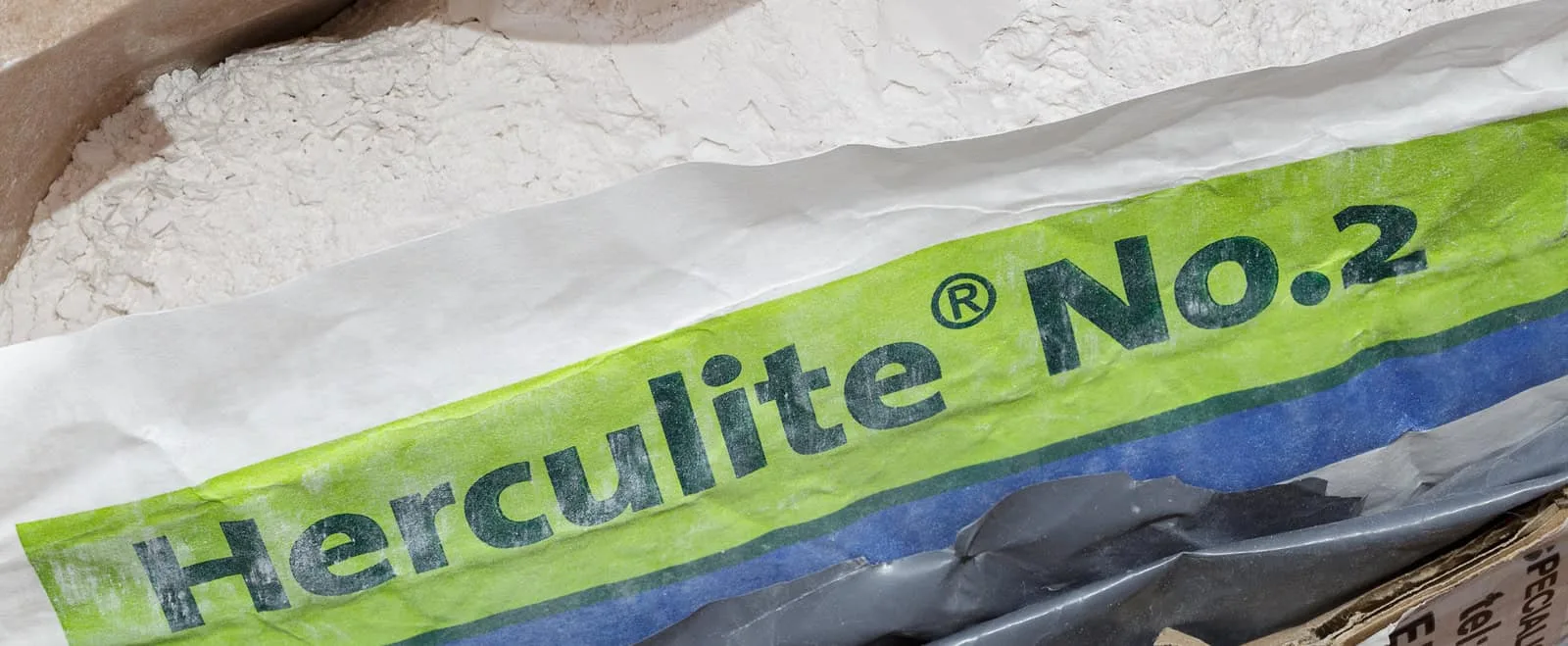
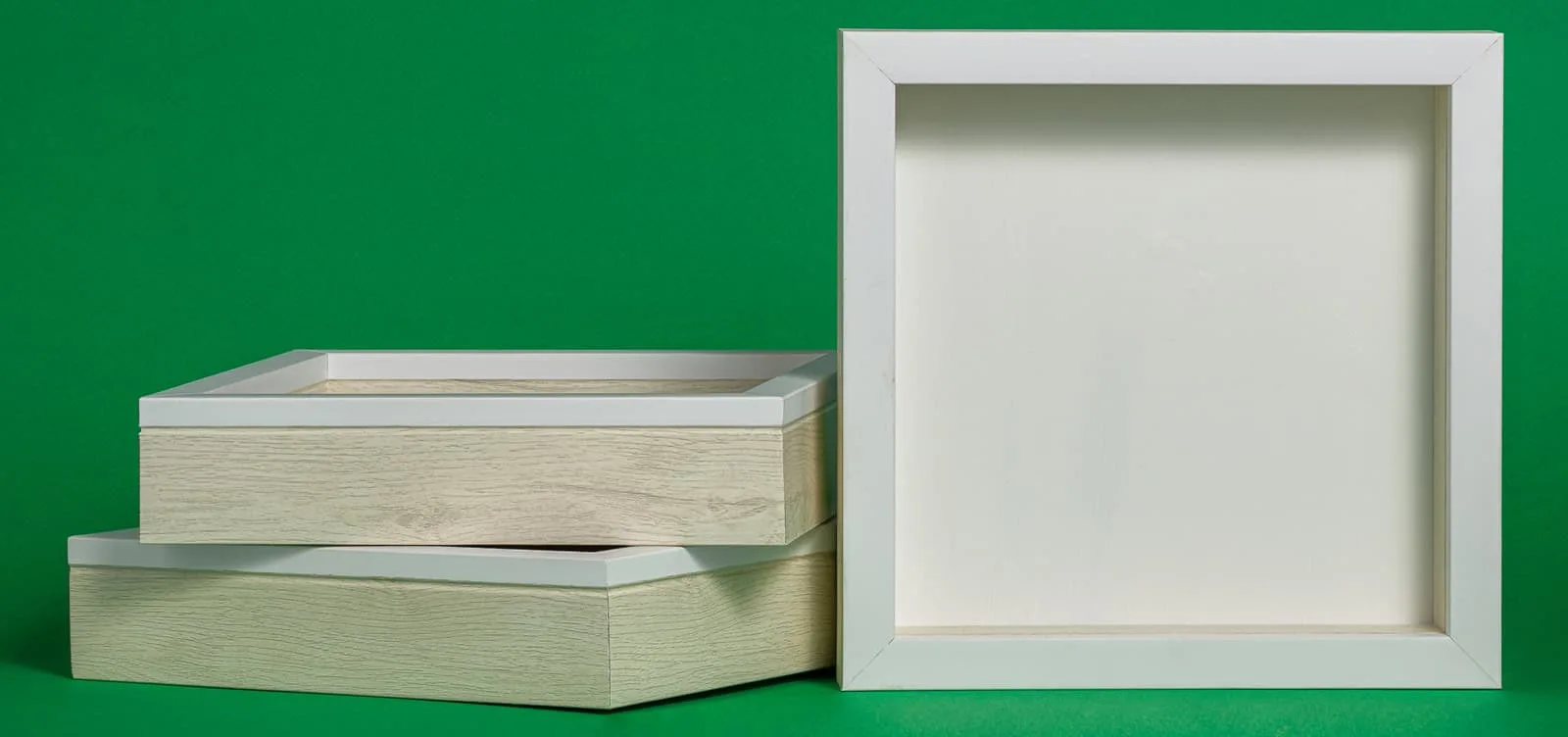
Would this process be done all in one go?
The first stage would take around a day, with the removal of the clay from the mould that same evening.
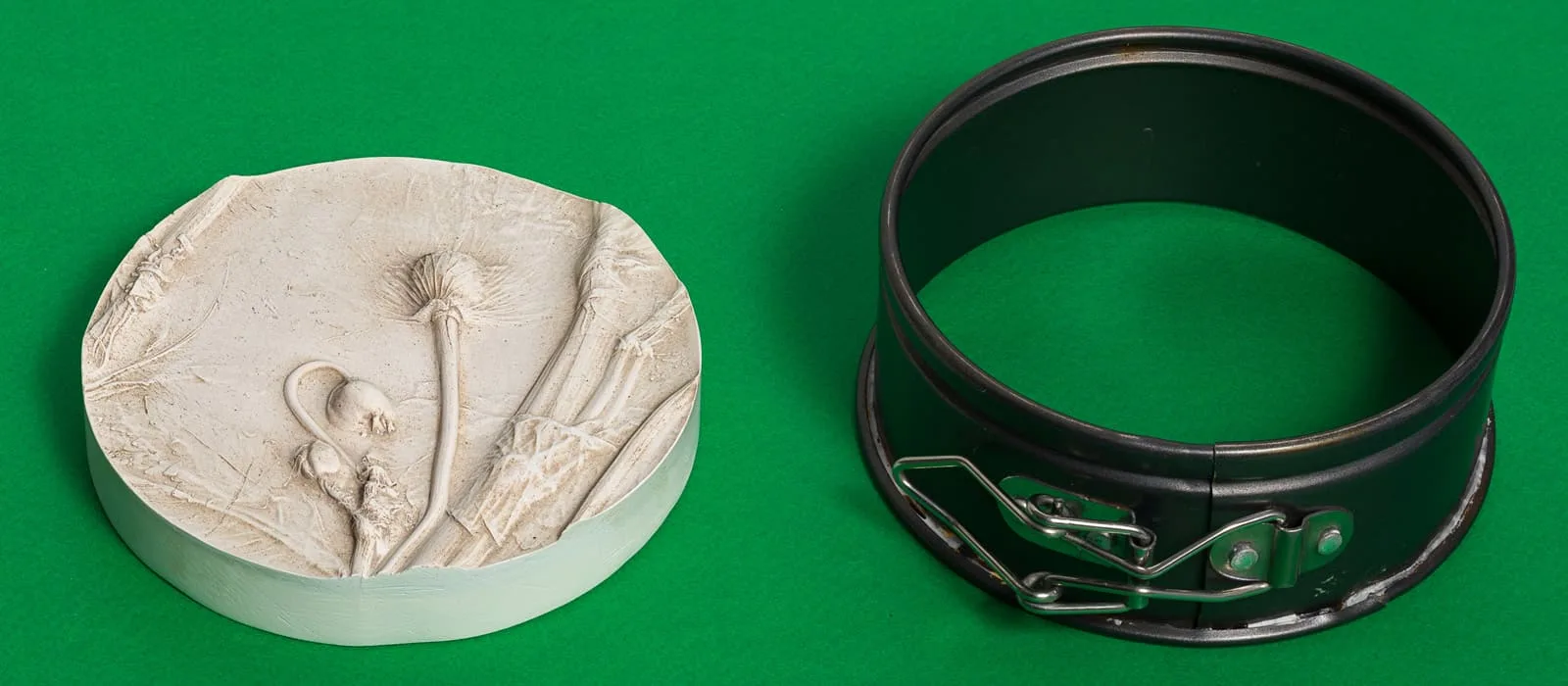
Can that mould be used again?
Sometimes. If I’m lucky I can get a second casting from the same mould, but as soon as it starts to harden it’s not really usable. They never come out the same way because they take on different elements from the clay mould each time.
So each one is unique?
Exactly. Then, once it’s out of the frame, it needs to be cleaned and bits of left-over clay removed. Once dry, I can sand the panel’s edges and smooth out any irregularities on the cast.
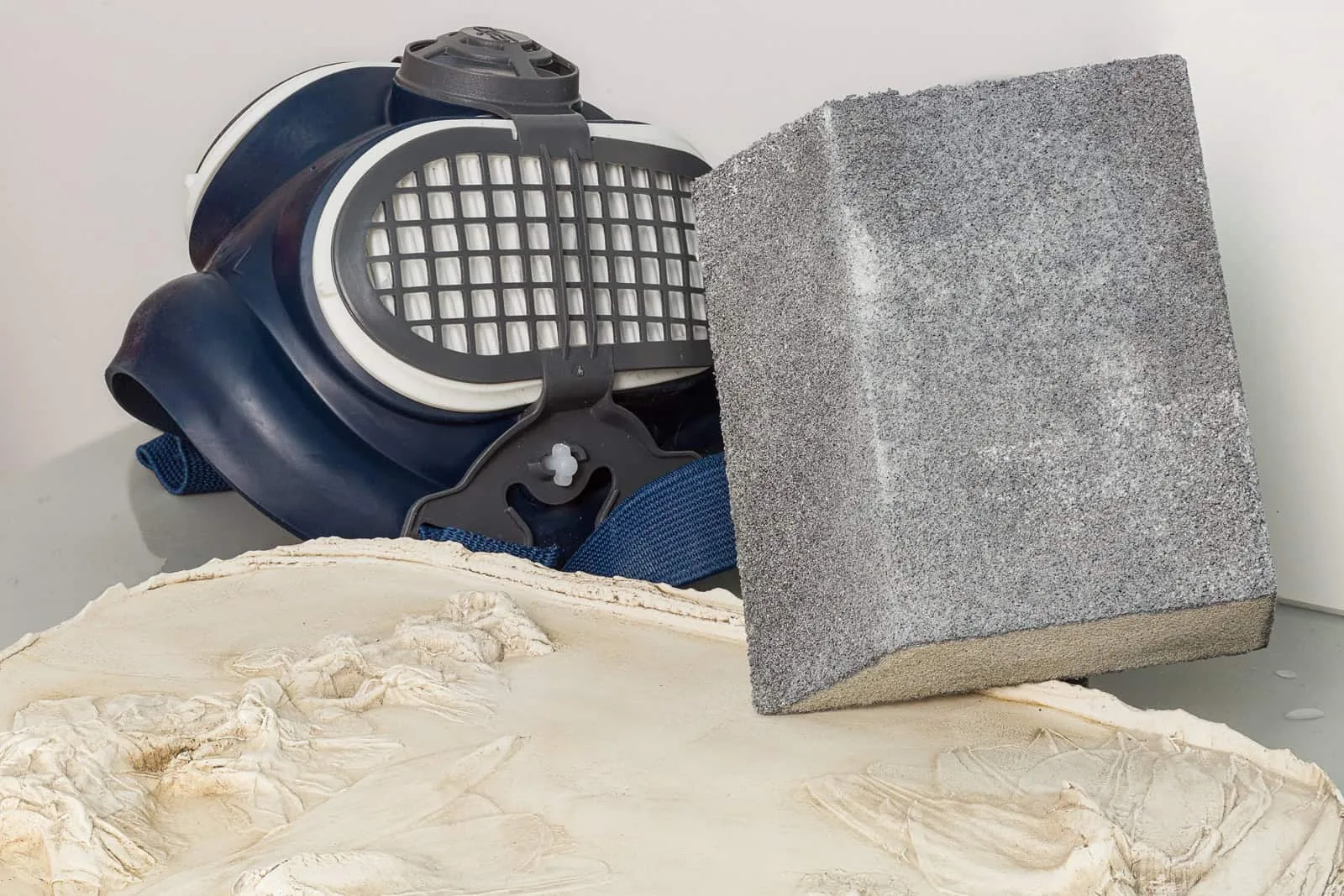
Is it mechanical sanding?
No. I use various grades of sandpaper to achieve the finish I’m after. I also want to leave a coating of clay on the raised parts, to highlight and define the texture and detail of plants.
REF: Wikipedia: [Extract]
Sandpaper is produced in a range of grit sizes and is used to remove material from surfaces. The grit size of sandpaper is usually stated as a number that is inversely related to the particle size. A small number such as 20 or 40 indicates a coarse grit, while a large number such as 1500 indicates a fine grit.
A couple of days later I might carry out more sanding in preparation for painting, or they can be left as is for their natural effect.
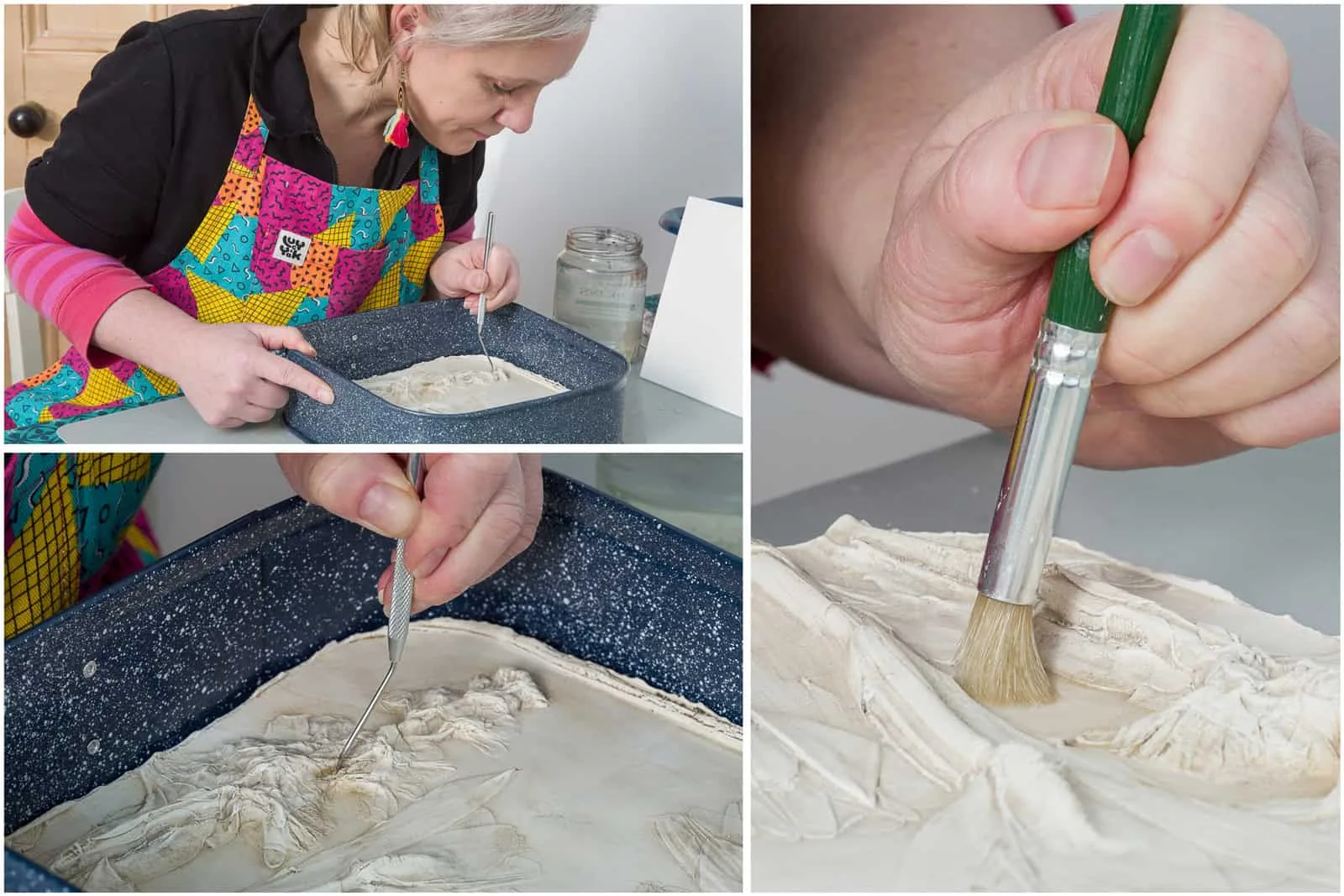
Cleaning a plaster of paris relief casting
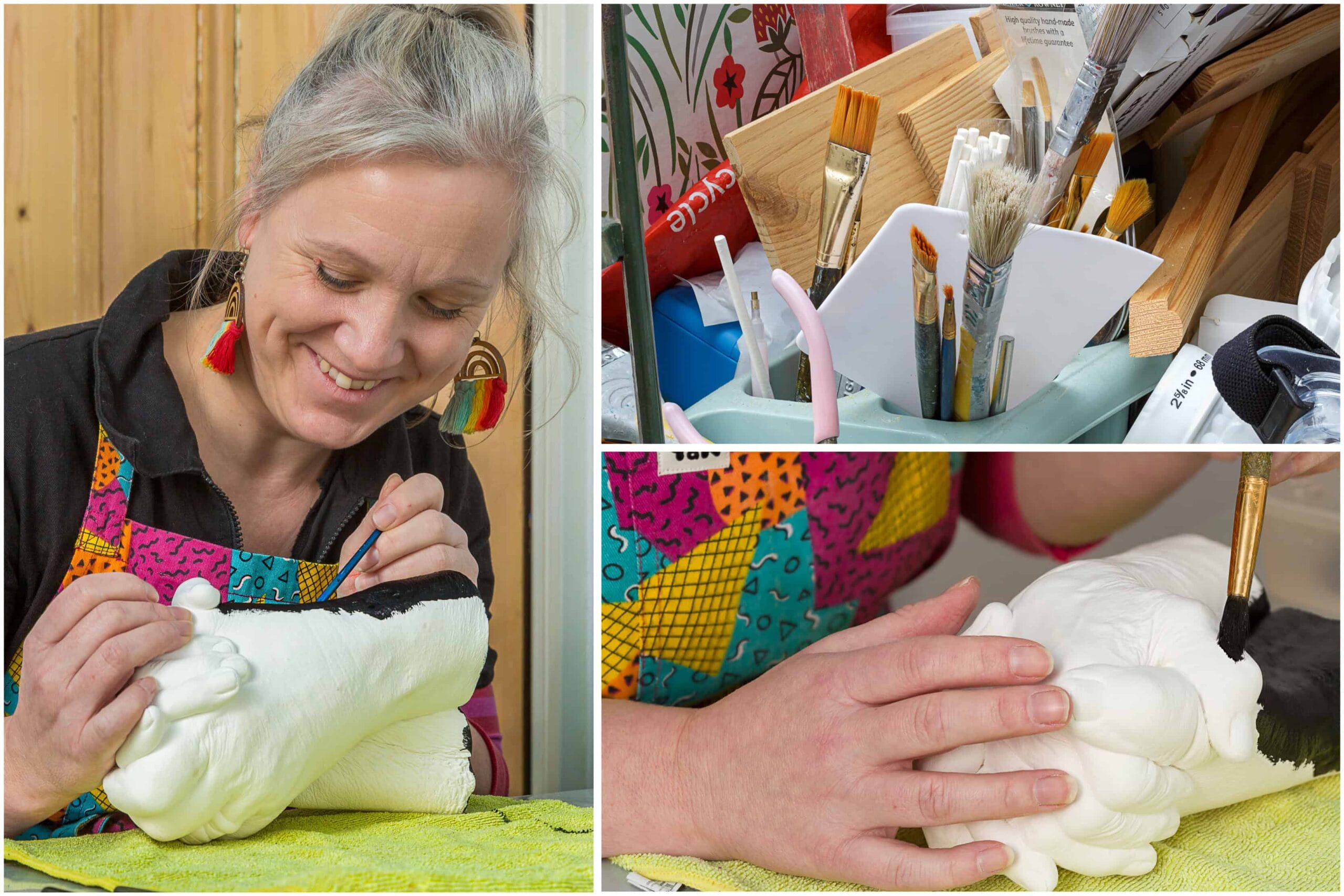
Painting a plaster of paris relief casting of a pair of adult hands
What’s your starting point for a piece of art; what inspires you to create?
The whole process is quite a mindful activity, and I feel that the reason I was drawn to art in the first place is that, one, I’m dyslexic, and two, I found it quite difficult to communicate when I was younger. Art became a way of expressing myself and getting my feelings out.
A sort of self-imposed therapy maybe?
Yes it is, and I think that having worked through COVID I decided that I needed this for myself. It’s my therapy, but I just so happen to be sharing it with others now [laughs].
Going back to what inspires me, I still use photography for capturing ideas…
As a visual notebook?
Yeah, it’s a bit like journaling. When I go for a walk, I have to take a photograph of things that I see. It might be something that other people wouldn’t necessarily notice, but it captures my imagination. I think that I’ve been so drawn to botanical casting because it reflects the act of being outside within the natural environment. Some people might call it foraging, but for me, it’s going for a walk where you can see and touch nature. You’re more aware of texture and colour, and the interplay of light when you’re not surrounded by the trappings of modern life. You’re just concentrating on what’s in front of you.
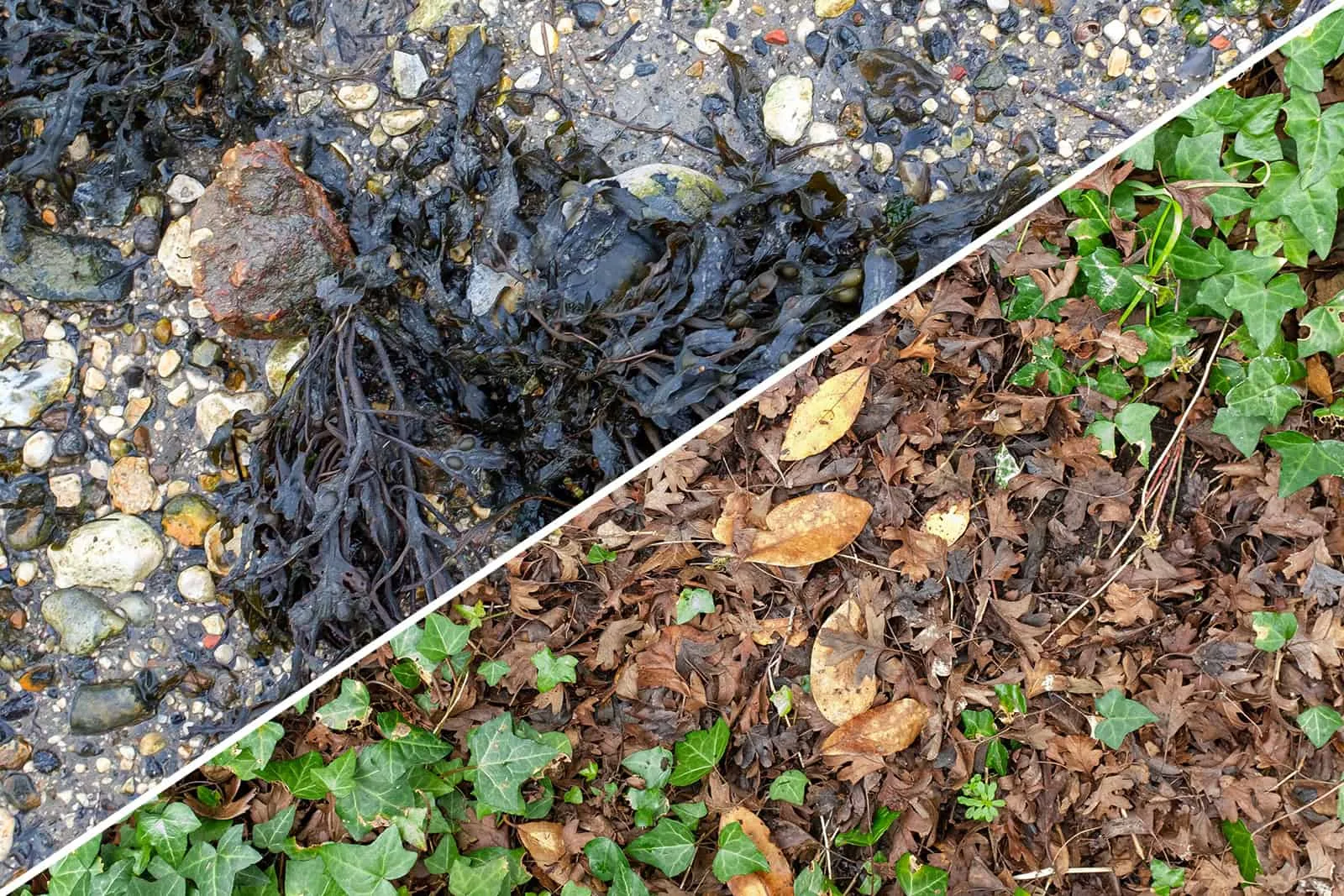
You’re in the moment, as they say.
Exactly, it all becomes much more sensory. Then that experience, for me at least, is added to when I’m working with the clay, the plaster and all the materials. The whole process is very focused. The cleaning of the plaster using the small tools is where all the details come to life. It’s very therapeutic.
It sounds like you enjoy the cleaning-up process as much as the artwork creation?
Definitely, but each part of the workflow has an appeal.
How do you decide what elements to use?
I’ve learnt along the way that it’s not just about something being pretty. It’s all about what the materials leave behind in the clay, their texture is really important for that. So for example, when I’m doing my coastal castings, I’m using things that I’ve found on the beach. A stone or shell might be beautiful to look at but that won’t necessarily be reflected in the final piece, so I’m more interested in how they feel to the touch. So that’s what guides my choice of elements. With foliage pieces, again it’s the leaves or flowers that have more texture to them.
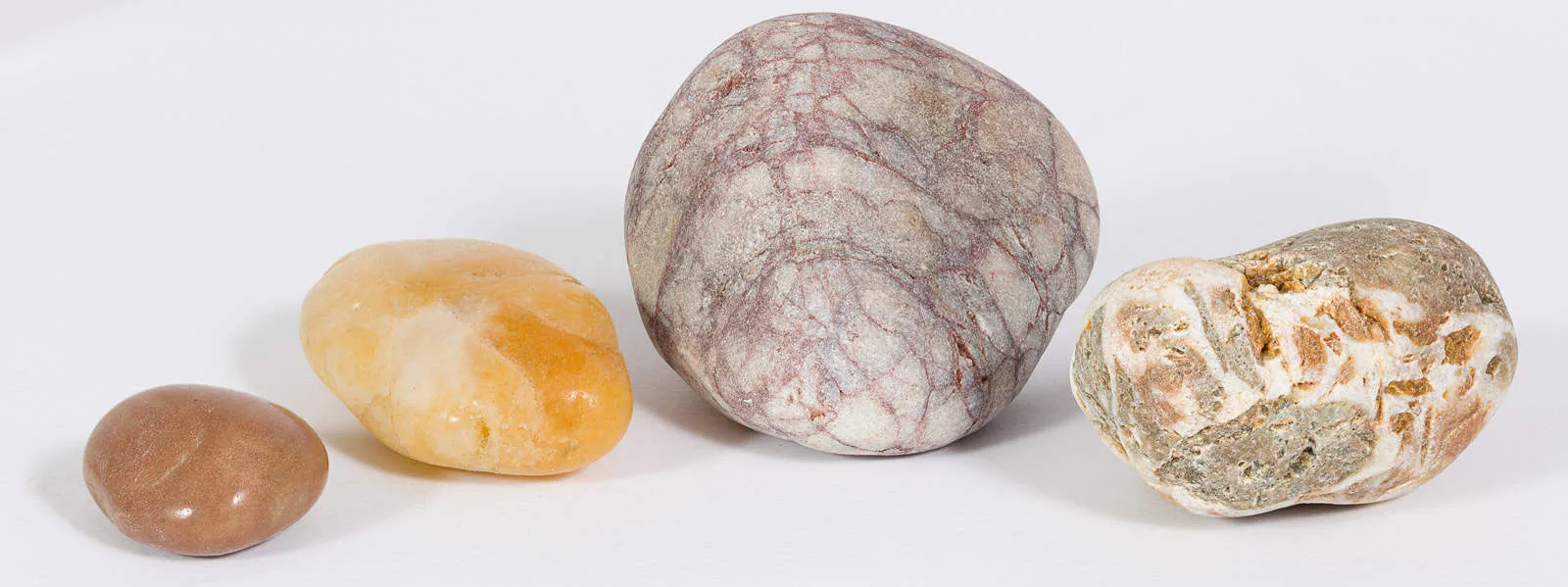
Not all surfaces are suitable for casting
So you don’t actually embed the leaves or flowers, for example, in the pieces, it’s using the impression that they leave behind when pressed into the clay, but in reverse so to speak.
That’s right, and that impression is what the plaster captures when it’s poured into the clay mould.
Would you consider yourself to be a sculptor?
I would say more of a mixed media artist. Not really a sculptor. I don’t know enough about that area of art [Laughs]
You work mainly with clay and plaster, did I read that you also use Alginate?
Where castings are created of hands and feet, I use Alginate, which is made from seaweed and isn’t harmful to the skin. Dentists use it for teeth moulds.
REF: Wikipedia: [Extract]
Alginates are refined from brown seaweeds. Throughout the world, many of the Phaeophyceae class brown seaweeds are harvested to be processed and converted into sodium alginate. Sodium alginate is used in many industries including food, animal food, fertilisers, textile printing, and pharmaceuticals. Dental impression material uses alginate as its means of gelling. Food grade alginate is an approved ingredient in processed and manufactured foods.
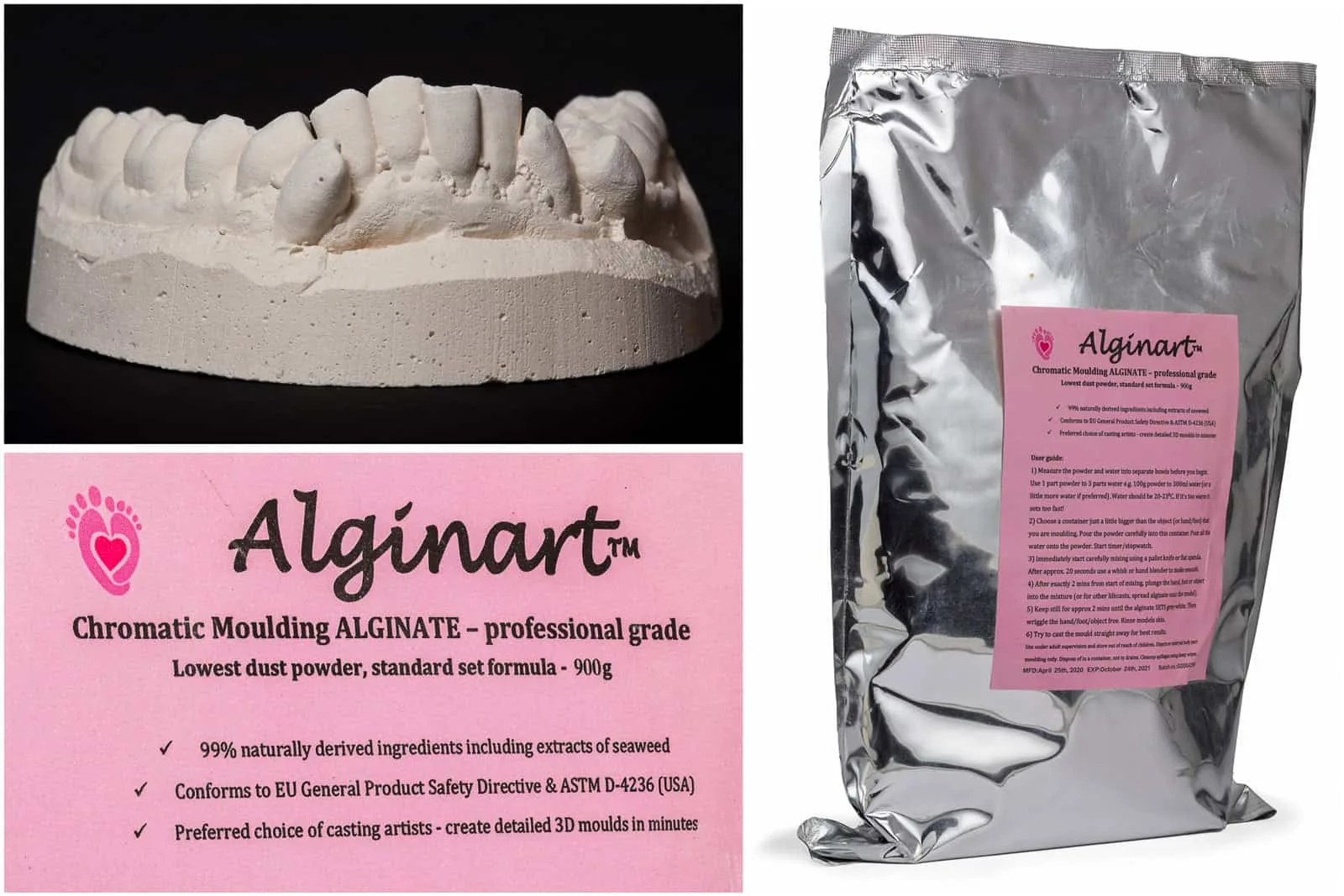
Is it a similar process to working with plaster?
Not too dissimilar. I mix up the Alginate powder with water, where it turns pink in colour. Then the hands, feet, or any other body parts [laughs] are dipped into the mixture until it turns grey, which is an indication that it has set. At this stage, it’s a bit like rubber so you can remove the hand or foot ready for filling with plaster when it’s dry.
Have you ever considered working with molten metal?
I would love to. I’m open to trying different media and techniques, where practical for my work space of course.
Are your art pieces seasonal? Are they governed by the availability of elements for example, or are you like most creatives where you’re always looking for and collecting items for later use?
I try to use what is growing in my garden, and what I can find at various times of the year. For instance, I recently created a few pieces that were shown at Portsmouth Cathedral as part of Portsmouth & Hampshire Art Society. My collection was called ‘Southsea Garden’. They were made using elements from my little garden. The blackberry bush, mint, french and english lavender and some poppies. This year we had loads of wild leeks, and they created some good moulds. So yes, the botanical pieces are seasonal.
Portsmouth & Hampshire Art Society show 2024 at Portsmouth Cathedral
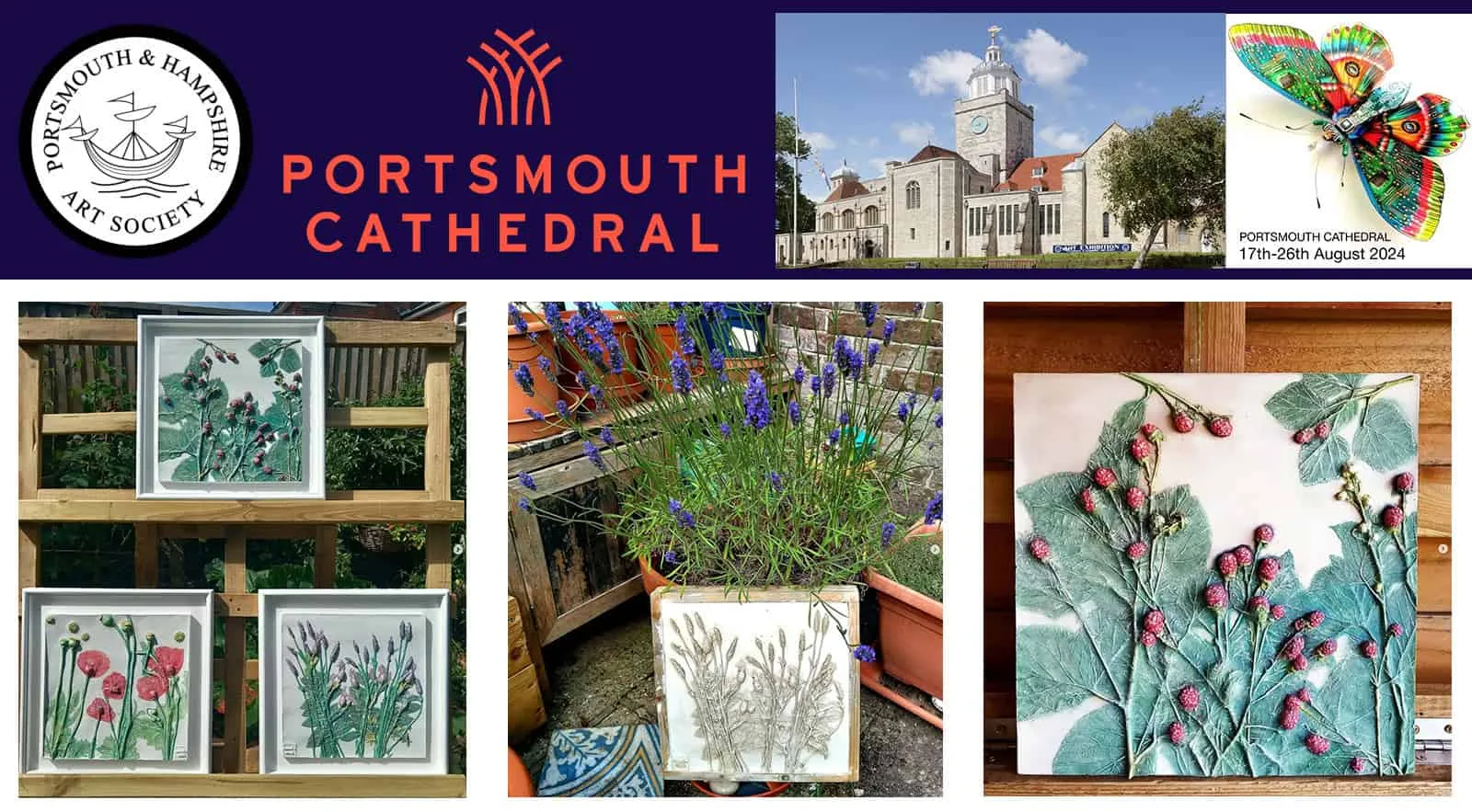
[Casting images courtesy of Jo Butler]
How are you for storage space? That always seems to be one of the limiting factors for artists.
We have a sunroom attached to the dining room, which is my storage area. Storage and studio space are the key constraints at the moment.
We expand to fill the space available as they say.
Exactly. When we first moved into our house we thought, “How are we ever going to fill this space, it’s so big?” And, of course, now it’s the opposite, it’s not big enough [Laughs]
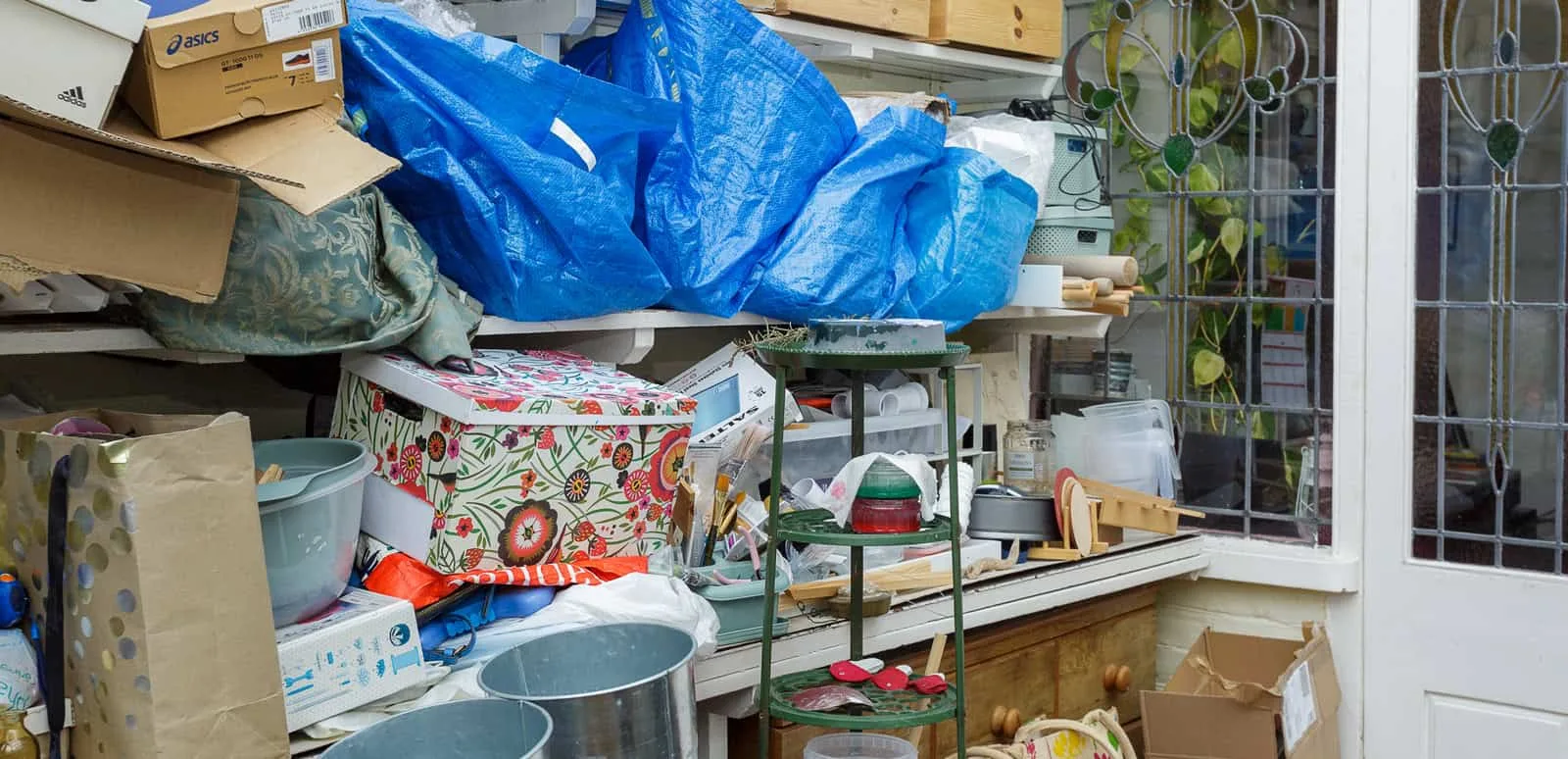
In the final part of Jo’s story, we talk about workshops, business collaborations and her favourite part of the artwork creation. Watch this space.

